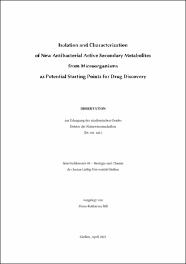| dc.description.abstract | Once considered the ‘magic bullet’, antibiotics no longer satisfy the wonder drug label as antimicrobial resistance (AMR) has largely eradicated the advantages given when first discovered more than 100 years ago. Stopped research efforts after ‘The Golden Age’ of antibiotics and the major challenges of antibacterial drug development (e.g., discovery of new compounds, performing clinical trials, economic value) resulted in the existing therapeutic gap contributing to the resistance crisis mankind is currently facing. As most large pharmaceutical companies dropped out of antibiotic research, small firms and research groups are left in the frontline. In order to prevent the 21st century from turning into the ‘post antibiotic era’, innovative partnerships between academia and industry combining innovative research with expertise represent one promising strategy.[ ] For this purpose, the Public Private Partnership between Fraunhofer IME and Sanofi (later Evotec) was established in 2014. The defined Target Product Profile (TPP) towards discovery of novel antibacterial compounds dictated a main focus on Gram negative (GN) ESKAPE pathogens and M. tuberculosis (Mtb). Rising to the tremendous challenge based on natural product (NP) research, a discovery platform was built on the Sanofi Fraunhofer strain collection harboring more than 120,000 different organisms further incorporating innovative screening approaches and focusing on underexplored phyla. Within this pipeline, isolation and structure elucidation of active metabolites focusing especially on novel chemistry remains a crucial part as it allows the identification of potential hit compounds for further hit expansion and lead generation.
In the present PhD thesis, four ‘active extract-to-hit’ (AE2H) projects covering both GN and Mtb active secondary metabolites from fungal and bacterial producers including the phylum Bacteroidetes were successfully accomplished. In total, the structures of all eight compounds identified by dereplication to cause the initial activity were elucidated comprising four so far unknown NPs. Additionally, 24 analogs were isolated including 14 new metabolites. Overall, the 32 compounds belong to four different NP classes: polyoxygenated and N heterocyclic arenes, linear peptides as well as amino- and phospholipids. Diverse isolation protocols were developed utilizing various techniques to obtain compounds of interest in sufficient quantity and of adequate purity. Therefore, optimization of fermentation conditions was beneficial. Structure elucidation was achieved by conclusive NMR spectroscopy and strongly supported by ESI QTOF MS/MS analysis. Assignment of relative and absolute configuration employed analytical methods (e.g., 2D ROESY NMR analysis) as well as chemical derivatization (e.g., Marfey’s Analysis) and stereoselective total synthesis. Moreover, synthetic chemistry was used to perform first SAR studies. For hit confirmation, bioactivity properties of all isolated and synthesized compounds was extensively investigated (MIC determination, in vitro TLR2/TLR4 and cytotoxicity assays). Overall, generated data finally encourage further efforts as promising starting points for future projects were presented. | de_DE |



